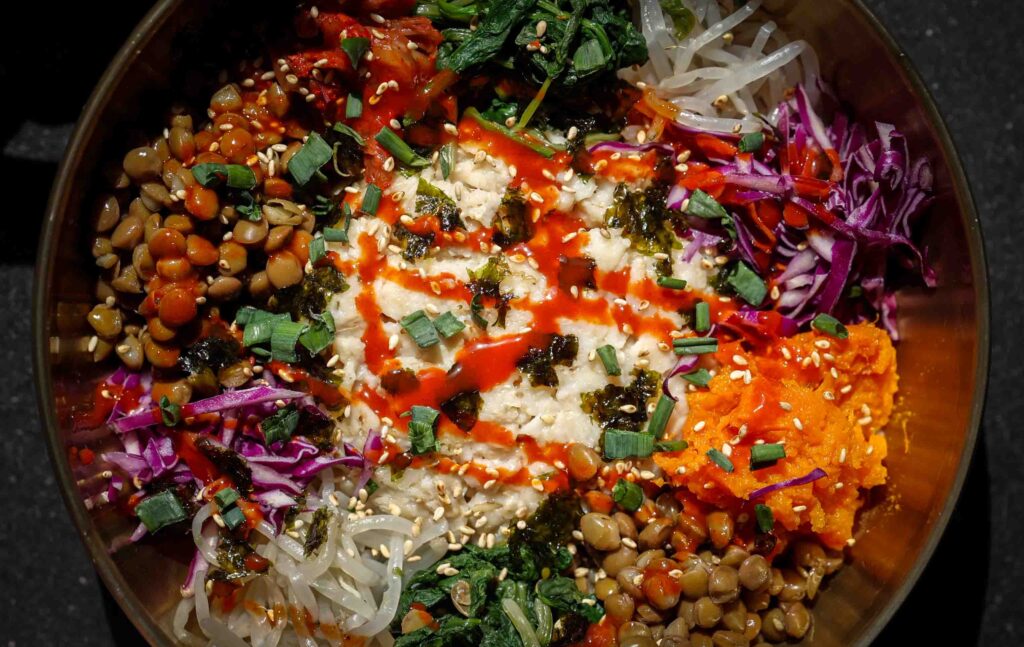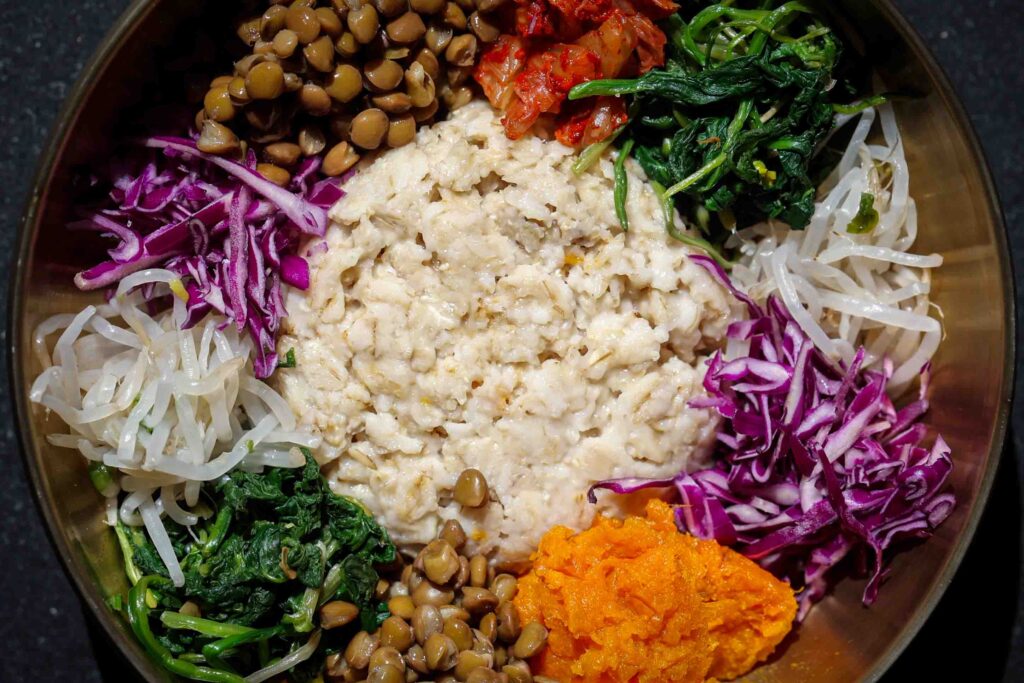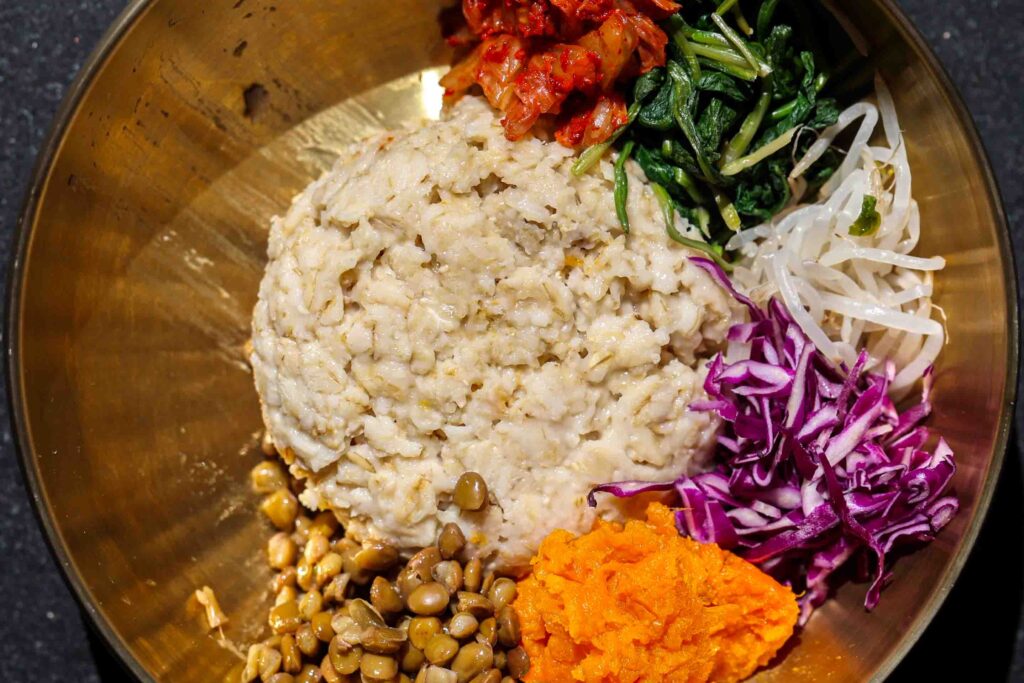Easy Heart-Healthy Savory Oatmeal Recipe: Bibim Oats

Easy. Healthy. Delicious.
If only these words could apply to everything we eat–from broccoli to French fries.
“Delicious” is not usually a word I’d use to describe a bowl of oats. But this savory oatmeal recipe is not only gorgeous, it’s seriously scrumptious. If you like bibimbap–that veritable icon of Korean comfort food–you will love this fancy bowl of oatmeal.
A savory breakfast is a great way to start your day, but just like sweet oatmeal isn’t the only way to eat your oatmeal, oatmeal doesn’t have to be relegated exclusively to the morning. Because savory oatmeal bowls provide great options for dinner, too!
In fact, I have a feeling that this savory oatmeal recipe might become a new favorite at any time of day!
So, without further ado, let’s get into it!
Disclaimer: Some of the links in this post may be affiliate links for products I use and love. If you make a purchase after clicking one of those links, I may earn a small affiliate commission, perhaps enough to buy some extra gochujang or gochugaru 🙂
First: How Do You Select The Best Kind of Oats for Savory Oatmeal?

“Steel cut oats,” “quick oats,” “quick-cooking-oats,” “quick-cooking steel-cut oats,” “rolled oats,” and “gluten free oats”…
What does it all mean?
I feel like there are so many different kinds of oats at the grocery store, it’s hard to know which type of oats you should purchase. Do you feel this way?
Here’s the skinny on the main varieties of oats you’ll find at your grocery store, as well as what I recommend for this savory oats recipe:
- Steel-Cut Oats. Steel-cut oats or “Irish oats” or “Scottish oats” are the least processed of all the oat varieties you’ll find on the shelves. They will thus have slightly more nutritional bang for your buck. That said, they take far longer than the other rolled varieties and tend to be a little pricier. When cooked, steel-cut oats tend to absorb less liquid and thus come out a bit chewier.
- Rolled Oats. Unlike steel-cut oats, “rolled oats” literally steam and press the whole grain in order to shorten the cook time. This does, however, come at a small cost–you get a bit less fiber content than steel-cut oats. That said, the difference is very small and, IMHO, well worth the amount of time you end up saving–where steel-cut oats take 30 minutes, rolled oats take 5 minutes. There are generally three different kinds of rolled oats:
- Old Fashioned Rolled Oats. Old fashioned rolled oats are steamed, rolled, and then flaked to create more texture. They absorb more liquid than steel cut oats and thus have a softer texture. They also take far less time than steel cut oats. I LOVE cooking with old fashioned rolled oats for my oatmeal recipes.
- Quick Oats or Quick-Cooking Oats. In order to reduce the cooking time even more, quick oats or quick-cooking oats are actually cooked, in advance. They are the thinnest of all the oat varieties and therefore pack very little texture.
- Instant Oats. While instant oats can be awfully convenient for a busy weekday morning, you really do have to pay attention to what might have been added to enhance the flavor of your small packet of instant oats. They will also be the most anemic of the oats, packing very little texture and mouthfeel.
- Gluten-Free Oats. Aren’t all oats gluten-free? Technically, yes. Unfortunately, the overwhelming majority of oats, including the virtually unprocessed steel-cut oats, are run through the same machines as gluten-full grains (like barley and wheat). Cross-contamination becomes a real possibility. Hence, it’s very likely that your bag of regular steel-cut oats is not entirely gluten-free. If you have Celiac’s disease, your best bet is purchase a bag that very clearly says “gluten-free,” to guard against cross-contamination.
But Aren’t Oats Bad For You…Now?
No.
The same people who are telling you that oats are bad for you are probably the same people who are saying that blueberries are bad for you.
Ok, I take that back. If you drown your oats in maple syrup, sprinkle them with bacon bits, and blanket them with a fried egg, then yes: whatever health benefits you would likely achieve by including oatmeal in your daily lineup will be crowded out by sugar, cholesterol, saturated fat, and sodium. By the way, the same thing would happen to a blueberry, broccoli, and even kale.
But your plain old bowl of humble oatmeal is about as healthy as it gets when it comes to fiber–the oft-neglected micronutrient that appears to be the lynchpin of longevity. Just one bowl of oatmeal contains 4 grams of fiber–about 15% of your daily recommended dosage.
What’s more is the kind of fiber brought to you by your bowl of oats. Specifically, oats contain beta glucan, a soluble fiber that hinders your body’s absorption of cholesterol, makes you feel fuller longer, and prevents sharp spikes in blood sugar. Oats are thus touted as one of the best foods to eat if you’re trying to lower your bad cholesterol. In fact, according to Harvard Health, “[a]mong all the grains, oats appear to be the most effective when it comes to lowering cholesterol.”
The main gripe that some folks seem to have with oats is that they may cause an increase in blood sugar because of their carb content. However, as we all know, not all carbs are created equal. Plain oats (i.e., not drowned in sugar) are relatively low on the glycemic index and therefore often do not result in blood sugar spikes. Adding protein and heart-healthy fats to your oats, in lieu of 2 tablespoons of brown sugar, can also dampen any blood sugar spikes.
Key Ingredients and Ideas for this Savory Oatmeal Recipe.

The great thing about this savory oatmeal recipe is that you’re in charge. There really are no “wrong” ways to do this thing–you can add whatever savory toppings you enjoy. That said, as I mentioned above, adding a cup of cheddar cheese or a ribeye steak will counteract whatever health benefits you might be aiming for with your savory oatmeal.
This savory oatmeal recipe is designed to promote heart-health and, as such, we’ll be sticking to mostly unprocessed whole foods (other than the sauce) that are entirely vegan. We’ll also be trying to incorporate plenty of pigmentation in our savory oatmeal bowl, because colorful food also promotes longer living, to wit:
- Boiled spinach. Boiled spinach is a classic Korean bibimbap ingredient and I think it’s a perfect addition to our savory oatmeal. Yes, you can absolutely substitute with sautéed spinach or raw baby spinach (I would not try to cook baby spinach), but boiling is the traditional way of preparing spinach for many Korean dishes. If you don’t want or have spinach, you can add blanched kale, fresh arugula, or even steamed broccoli!
- Boiled mung bean sprouts. Mung bean sprouts also frequently make an appearance on the Korean dining table and certainly in bibimbap. I find that boiling them is the easiest way to prepare them, though, again, you can always sauté them, as well. You can substitute with whatever is your favorite sprout, though some of the more delicate varieties (e.g., broccoli sprouts) should not be cooked first.
- Red Cabbage. Red cabbage not only adds a splash of purple to our savory oatmeal, but plenty of CRUNCH! I like to keep the cabbage raw for precisely that purpose. You can substitute with any cabbage-like vegetable, including green cabbage, napa cabbage, or even brussels sprouts!
- Kimchi. I am NEVER going to pass up on an opportunity to incorporate the burst of flavor and amazing probiotic benefits of kimchi! If you don’t have good kimchi at your disposal, you should make my kimchi recipe! But, you can also substitute with your favorite pickled vegetable–might I recommend pickled red onions!
- Lentils. One of my favorite things about plant-based proteins is that they have fiber, unlike that hunk of chicken breast. Statistically speaking, you are not eating enough fiber (I know I’m not), so I’ll take every chance I can to sneak more fiber into our bowl. Lentils are a great option for this, but so are black beans, pinto beans, garbanzo beans, cannellini beans. For the sake of convenience, I’m using canned lentils but you can, of course, cook your own legumes.
- Garnet Yams or Sweet Potatoes. Did you know that “garnet yams” are not yams at all? They are, in fact, sweet potatoes, but crappy labeling conventions resulted in this literal misnomer. Regardless, I wanted to add a very bright, colorful sweet potato to this dish to provide a slightly different texture and, of course, more fiber. You can substitute with yams, of course, as well as even darker sweet potatoes (like purple sweet potatoes). You can also substitute with carrots!
- Gochujang. I took a cue from bibimbap and created a very simple but spicy sauce to go with our savory oatmeal by using gochujang. If you don’t have gochujang, you can also use hot sauce, red miso, white miso, a flavored hummus, or your favorite store bought salad dressing. You can also just skip the sauce altogether and simply add a drizzle of olive oil, sesame oil, chili oil, or soy sauce over your savory oatmeal.
- Roasted Seaweed. I got the idea to make savory oatmeal from my mom–she told me she liked to add seaweed to her oatmeal in the morning. Mind blowing. It turns out many people add a little “gim” (seaweed) to their bibimbap!
Other Ideas for Savory Oatmeal:
- Cherry tomatoes
- Sun-dried tomatoes
- Caramelized onions
- Nutritional yeast
- Fresh herbs (e.g., basil)
- Spices (e.g., curry powder, garlic powder, smoked paprika)
How To Make Savory Oatmeal.


Making savory oatmeal is extremely easy. For this heart-healthy savory oatmeal, we’ll either be boiling or baking all of our cooked ingredients.
First, start with the ingredient that will take the longest to prepare: sweet potato. Throw that bad boy in the oven and crank the heat up to 450° F. My sweet potatoes take anywhere from 60 to 90 minutes, but if you use an air fryer, you can often halve that time.
Next, prepare your spinach by bringing a medium pot of water to a boil. Drop your spinach into the water and cook for 1 minute, by which time your spinach will turn a brilliant green. Remove the spinach from the boiling water (don’t discard) and run the spinach under cold water to stop the cooking process. Then, squeeze out as much excess water from your spinach as possible. Set aside.
Then, make your mung bean sprouts by dropping them into the same pot of boiling water in which you cooked your spinach. Cook for about 7 minutes, until your mung beans begin to grow translucent and soft. Drain and run under cold water. Pat dry and set aside.
Then, make your oatmeal. If you’re using old fashioned roll oats as I recommend, simply cook them according to package instructions, except use vegetable broth, in lieu of water. Using vegetable broth will add tons of flavor to your savory oatmeal. Of course, if you don’t have any vegetable broth on hand, you can always use water. After cooking your oatmeal, I like to let it rest a bit, so that it has a chance to “firm up.”
And finally, the sauce: simply whisk together a little gochujang, vinegar, a little sweetener, and water. Done!
Compose your bowl by adding your ingredients, drizzling with a bit of sauce, and garnishing with toasted sesame seeds and chopped scallion greens. Voila!!
The best bowl of savory oatmeal you never knew you could have!
Frequently Asked Questions.
Isn’t oatmeal bad for you now?
No. Oatmeal, by itself, is an extremely heart-healthy addition to your diet, with the proven ability to lower bad cholesterol. However, many popular “instant oatmeal” products add processed and sugary ingredients that counteract many of the whole grain’s natural health benefits.
Are all oats gluten-free?
Oats are naturally gluten-free; however, many commercially sold oat products are processed and packaged using the same equipment as non-gluten-free grains (like barley and wheat). Accordingly, there is a high-risk of cross contamination. For those aiming to avoid any trace of gluten, it’s best to opt for a product that is clearly labeled as “gluten-free.”
But isn’t oatmeal usually a sweet dish?
No! Savory oatmeal is a great way to incorporate this fiber-rich whole grain into more than just breakfast. While oatmeal is a great healthy breakfast option, a savory oatmeal can also be an excellent choice for lunch or dinner.
Recipe Card

Easy Savory Oatmeal Recipe (Bibim Oatmeal)
Ingredients
- 2 1/4 cup vegetable broth
- 1 cup old fashioned rolled oats
- 1/2 cup baked garnet sweet potatoes
- 2 cups spinach
- 1/2 cup mung bean sprouts
- 1/2 cup finely julienned red cabbage
- 1 cup cooked lentils
- 1/2 cup kimchi
For the Gochujang Dressing.
- 1 tbsp gochujang
- 1 tsp rice vinegar
- 1 tsp maple syrup
For Garnish.
- 2 tbsp torn up roasted seaweed
- 2 tbsp chopped scallion greens
- 2 tsp toasted sesame seeds
Instructions
- Cook your oats according to package instructions, but replace the water with vegetable broth. Once the oats are cooked, set them aside and allow them to cool for about 10 minutes.
- While your oats are cooking, add spinach to a pot of boiling water for about 1 minute, until it turns bright green. Remove spinach from pot (do not discard water) and drain, running the spinach under cold water to stop the cooking. Squeeze out as much excess liquid as possible and set aside.
- Add mung bean sprouts to same pot of boiling water. Cook for about 7 minutes, until they begin to turn translucent and soft. Drain under cold water, pat dry, and set aside.
- Add your cooked oats in the center of the bowl. Arrange the remaining ingredients around the cooked oats.
- Make the Gochujang Dressing by whisking all the ingredients together with 1 tablespoon of water. Drizzle over your bowl of oatmeal.
- Garnish with seaweed, sesame seeds, and chopped scallion greens.
Questions & Comments
April 1, 2024
Join The Discussion
April 1, 2024

Cooking method says to cook the oats in vegetable oil but the post describes water or veg broth. Please clarify.
Ciao! Yes this was a typo but was fixed earlier this morning. It should be vegetable broth. Please let me know if it still shows up as vegetable oil—it shows up as broth from here. Thank you!! (Imagine cooking oatmeal in oil!! 😅)
Could the oatmeal in your recipe call for vegetable broth instead of oil?
Yes! Sorry it was meant to read vegetable broth, not oil!